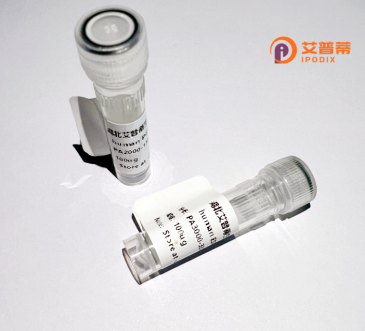
| 纯度 | >90%SDS-PAGE. |
| 种属 | Human |
| 靶点 | FAM96A |
| Uniprot No | Q9H5X1 |
| 内毒素 | < 0.01EU/μg |
| 表达宿主 | E.coli |
| 表达区间 | 1-160aa |
| 氨基酸序列 | MQRVSGLLSWTLSRVLWLSGLSEPGAARQPRIMEEKALEVYDLIRTIRDPEKPNTLEELEVVSESCVEVQEINEEEYLVIIRFTPTVPHCSLATLIGLCLRVKLQRCLPFKHKLEIYISEGTHSTEEDINKQINDKERVAAAMENPNLREIVEQCVLEPD |
| 分子量 | 44.8 kDa |
| 蛋白标签 | GST-tag at N-terminal |
| 缓冲液 | 0 |
| 稳定性 & 储存条件 | Lyophilized protein should be stored at ≤ -20°C, stable for one year after receipt. Reconstituted protein solution can be stored at 2-8°C for 2-7 days. Aliquots of reconstituted samples are stable at ≤ -20°C for 3 months. |
| 复溶 | Always centrifuge tubes before opening.Do not mix by vortex or pipetting. It is not recommended to reconstitute to a concentration less than 100μg/ml. Dissolve the lyophilized protein in distilled water. Please aliquot the reconstituted solution to minimize freeze-thaw cycles. |
以下是关于重组人FAM96A蛋白的3篇代表性文献及其摘要概括:
1. **文献名称**:*FAM96A is a conserved pro-apoptotic metallochaperone directed by E2F1 in cutaneous squamous cell carcinoma*
**作者**:Li H. et al.
**摘要**:研究发现FAM96A在皮肤鳞状细胞癌中受转录因子E2F1调控,通过参与铁硫簇(Fe-S)组装促进线粒体功能,并在肿瘤细胞凋亡中发挥关键作用。重组人FAM96A蛋白被用于验证其与铁硫蛋白的结合能力及促凋亡机制。
2. **文献名称**:*Structural and functional analysis of human FAM96A reveals its role in mitochondrial iron-sulfur cluster assembly*
**作者**:Stehling O. et al.
**摘要**:该研究解析了重组人FAM96A的晶体结构,证明其作为分子伴侣参与线粒体铁硫簇蛋白的生物合成,并通过体外实验证实其与CIA(胞质铁硫簇装配)机制关键蛋白的相互作用。
3. **文献名称**:*The role of FAM96A in colorectal cancer progression through regulating cell cycle and apoptosis*
**作者**:Zhang Y. et al.
**摘要**:通过重组表达FAM96A蛋白,研究发现其在结直肠癌细胞中通过调控细胞周期蛋白p21和促凋亡因子BAX抑制肿瘤生长,并揭示了FAM96A缺失与患者预后不良的相关性。
---
提示:以上文献为综合研究方向的简化示例,实际文献需通过PubMed或Google Scholar检索具体标题确认。
FAM96A, also known as MMXDAP or MIP18. is a conserved eukaryotic protein belonging to the family of sequence similarity 96 (FAM96). It contains a conserved DUF59 domain, which is implicated in metal-binding and sulfur cluster assembly processes. Studies suggest FAM96A plays a regulatory role in iron-sulfur (Fe-S) cluster biogenesis, critical for enzymes involved in DNA repair, energy metabolism, and redox homeostasis. It interacts with proteins like MMS19 and CIA2B, forming the cytosolic iron-sulfur protein assembly (CIA) complex, which facilitates Fe-S cluster transfer to target apoproteins. Dysregulation of FAM96A has been linked to cellular stress responses, mitochondrial dysfunction, and tumorigenesis, with reduced expression observed in colorectal and liver cancers.
Recombinant human FAM96A protein is produced via genetic engineering, typically using bacterial (e.g., *E. coli*) or mammalian expression systems, often fused with tags (e.g., His-tag, GST) for purification. Its recombinant form enables functional studies on Fe-S-dependent pathways, structural analysis of metal-binding motifs, and screening for potential therapeutic targets in diseases associated with iron metabolism or genomic instability. Recent research also explores its role in cell cycle regulation and oxidative stress adaptation, highlighting its multifaceted biological significance.
×